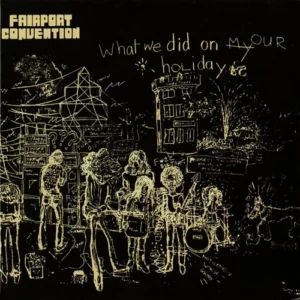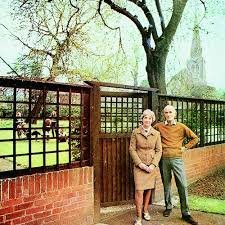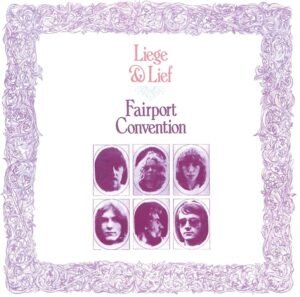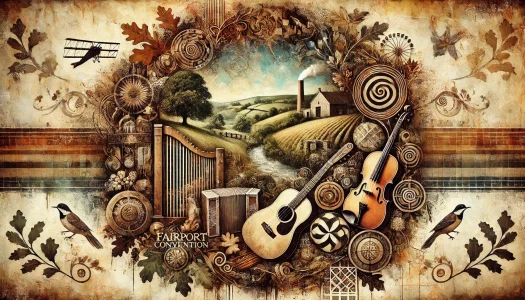Fairport Convention stands as a cornerstone in the landscape of British folk music, embodying the fusion of traditional melodies with contemporary rock influences. Formed in 1967, the band quickly distinguished itself by blending the rich, narrative-driven essence of British folk with the electric energy of rock, creating a unique sound that would become their hallmark. Their innovative approach not only revitalized traditional British folk music but also set the stage for a new era of musical exploration and cultural appreciation.
Formation and Early Years
Fairport Convention was formed in 1967 by bassist Ashley Hutchings and guitarist Simon Nicol, who were soon joined by Richard Thompson on guitar, Martin Lamble on drums, and Judy Dyble as the initial lead vocalist. The band was named after the house where Nicol’s mother lived, “Fairport,” and their early practice sessions took place in the family home.
The group’s initial sound was heavily influenced by the folk rock movement burgeoning in the United States, particularly drawing inspiration from artists like Bob Dylan and The Byrds. Their early repertoire included a mix of contemporary American folk-rock covers and traditional folk songs, delivered with a distinctly British flair. This eclectic blend was evident in their self-titled debut album released in 1968, which showcased their ability to reinterpret American folk tunes while beginning to carve out their unique identity.
Fairport Convention’s early performances in London’s vibrant club scene helped them hone their sound and build a following. Their music stood out for its intricate guitar work, innovative arrangements, and the harmonious blending of traditional folk elements with the electric dynamism of rock. This period was marked by a sense of exploration and experimentation, laying the groundwork for the more definitive folk-rock fusion that would come to characterize their later work.
Breakthrough and Key Albums
Fairport Convention’s breakthrough came in 1969 with a trio of seminal albums that would cement their place in music history: “What We Did on Our Holidays,” “Unhalfbricking,” and “Liege & Lief.”
“What We Did on Our Holidays”

Released in January 1969, this album showcased the addition of Sandy Denny, whose distinctive voice and songwriting prowess brought a new dimension to their music. The album featured a mix of original songs and covers, including Denny’s haunting “Fotheringay” and a striking rendition of Bob Dylan’s “I’ll Keep It with Mine.” This record illustrated Fairport Convention’s growing confidence and ability to blend traditional folk with modern sensibilities.
“Unhalfbricking”

Just a few months later, in July 1969, “Unhalfbricking” followed. This album saw the band further exploring their folk roots while continuing to incorporate contemporary influences. Notable tracks included “Who Knows Where the Time Goes?” penned by Denny, and the epic “A Sailor’s Life,” which hinted at the fully-fledged folk-rock direction they would soon embrace. The inclusion of three Bob Dylan covers, reinterpreted through their unique lens, underscored their deep respect for the American folk tradition while firmly rooting their sound in British soil.
“Liege & Lief”

The pinnacle of Fairport Convention’s early period came with “Liege & Lief,” released in December 1969. Often hailed as the definitive British folk-rock album, “Liege & Lief” was a bold reimagining of traditional British folk music. This record saw the band embracing ancient ballads and jigs, reworking them with electric instrumentation and innovative arrangements. Tracks like “Matty Groves,” “Tam Lin,” and “Crazy Man Michael” exemplified this synthesis, combining Richard Thompson’s virtuosic guitar work with Denny’s evocative vocals and the band’s dynamic rhythm section.
Influences and Inspirations
Fairport Convention’s music was deeply rooted in the rich tapestry of traditional British folk music and stories, which provided a wellspring of inspiration for their work. The band drew extensively from centuries-old ballads, jigs, and reels, weaving these elements into their modern compositions. Songs like “Matty Groves” and “Tam Lin” from their album “Liege & Lief” are prime examples of how they revived and reimagined ancient tales, bringing them to new audiences with electrifying arrangements and contemporary sensibilities.
Traditional British folk music is characterized by its narrative-driven lyrics and melodies that often recount historical events, folklore, and everyday life. This tradition resonated with Fairport Convention, whose members delved into collections of folk songs, such as those compiled by Cecil Sharp and Francis James Child, to uncover forgotten gems. The band’s arrangements respected the essence of these traditional tunes while infusing them with the energy and innovation of the 1960s rock scene.
Contemporary Influences
In addition to their deep appreciation for traditional British folk, Fairport Convention was significantly influenced by contemporary musicians and genres. The American folk revival of the 1960s, spearheaded by artists like Bob Dylan and Joan Baez, played a crucial role in shaping their early sound. Dylan’s poetic lyricism and Baez’s interpretive skills inspired Fairport to explore the narrative potential of their music and to experiment with different songwriting styles.
The burgeoning British rock scene also left its mark on Fairport Convention. Bands like The Beatles and The Byrds influenced their use of electric guitars and innovative recording techniques. The Byrds, in particular, with their pioneering blend of folk and rock, provided a blueprint that Fairport would expand upon with their uniquely British approach.
The impact of these contemporary influences can be heard in the band’s seamless integration of traditional and modern elements. Their early albums featured covers of Dylan’s songs, while their later work demonstrated a more sophisticated fusion of rock instrumentation with folk melodies and rhythms. This blend of the old and the new not only defined Fairport Convention’s sound but also helped to bridge the gap between generations, making traditional folk music relevant and accessible to a 20th-century audience.
Key Members and Contributions
Fairport Convention’s success and enduring influence can be attributed to the exceptional talents and contributions of its key members, each bringing a unique element to the band’s sound and legacy. Among them, Richard Thompson, Sandy Denny, and Ashley Hutchings stand out as pivotal figures.
Richard Thompson
A founding member and the band’s lead guitarist, Richard Thompson is renowned for his virtuosity and innovative playing style. His distinctive guitar work, characterized by intricate fingerpicking and fluid solos, became a defining feature of Fairport Convention’s sound. Thompson’s songwriting skills also played a crucial role in the band’s evolution. He penned many of their classic tracks, such as “Meet on the Ledge” and “Crazy Man Michael,” blending traditional folk themes with contemporary issues. Thompson’s ability to fuse rock energy with folk sensibilities helped shape the band’s identity and paved the way for their unique fusion of genres.
Sandy Denny
Sandy Denny joined Fairport Convention in 1968, bringing with her a voice that would become synonymous with the band’s most celebrated period. Her ethereal, emotive vocals added depth and resonance to their music, elevating songs like “Who Knows Where the Time Goes?” and “Fotheringay” to timeless status. Denny’s songwriting prowess was equally impactful, contributing some of the band’s most memorable and enduring pieces. Her interpretations of traditional songs, infused with her own emotional intensity and lyrical sophistication, helped bridge the gap between the old and the new. Denny’s tenure with Fairport Convention left an indelible mark, and she remains a revered figure in the world of folk music.
Ashley Hutchings
As the bassist and a founding member, Ashley Hutchings was the driving force behind Fairport Convention’s exploration of traditional British folk music. His deep knowledge of folk traditions and his passion for preserving and revitalizing them were instrumental in steering the band towards a more folk-oriented sound. Hutchings’ vision culminated in the groundbreaking album “Liege & Lief,” which is often credited with laying the foundation for the British folk-rock movement. His meticulous research into folk songs and his innovative arrangements helped Fairport Convention achieve a synthesis of ancient melodies and modern rock that was both authentic and revolutionary. After leaving the band, Hutchings continued to champion folk music, forming other influential groups like Steeleye Span and the Albion Band.
Cultural Impact and Legacy
Fairport Convention played a pivotal role in the British folk revival, leaving an indelible mark on the musical landscape and influencing a multitude of artists. Their innovative fusion of traditional British folk music with contemporary rock elements redefined the genre and revitalized interest in the country’s musical heritage.
One of the most significant ways Fairport Convention shaped the British folk revival was by demonstrating that traditional folk music could be relevant and appealing to modern audiences. Their groundbreaking album “Liege & Lief,” released in 1969, is often hailed as the cornerstone of the British folk-rock movement. By reinterpreting centuries-old folk songs with electric instrumentation and dynamic arrangements, they created a fresh and exciting sound that resonated with the countercultural youth of the time. This album’s success not only brought traditional folk music back into the public consciousness but also set a new standard for folk-rock fusion.
Fairport Convention’s influence extended far beyond their own recordings. They inspired a wave of musicians and bands to explore and embrace traditional British folk music. Artists like Steeleye Span, Pentangle, and even contemporary acts such as Mumford & Sons have cited Fairport Convention as a key influence in their work. The band’s willingness to delve into the rich tapestry of British folklore and present it with modern sensibilities encouraged others to do the same, fostering a new generation of folk musicians who continue to draw from these deep-rooted traditions.
Lasting Legacy
The annual Cropredy Festival, started by Fairport Convention in the late 1970s, has become a significant event in the folk music calendar. This festival not only celebrates the band’s legacy but also serves as a platform for emerging folk artists to showcase their talents. The ongoing popularity of Cropredy is a testament to the band’s enduring impact and their role in sustaining and nurturing the folk music community.
Fairport Convention also contributed to the re-popularization of traditional British folk music through their meticulous research and authentic performances. By bringing forgotten folk songs to new audiences, they helped preserve and perpetuate an important part of the nation’s cultural heritage. Their influence can be seen in the continued interest in folk music education and the numerous folk clubs and societies that thrive across the UK today.
